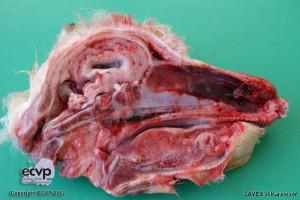
Animal: Lamb, stillbirth, female.
Diagnosis: Lamb, cerebrum and cerebellum. Severe cerebellar hypoplasia and mild to moderate hydrocephalus internus.
Description: There is an abnormal accumulation of fluid within the cerebral ventricular system. The cerebral ventricular system is also distended. The folial pattern and division into lobes of the cerebellum appears normal but it was reduced in size.
Comments: Necropsy revealed a moderate arthrogryposis of the fore- and hind limb, a torticollis and a brachygnathia inferior. Furthermore a severe hypoplasia of musculature of the affected limbs occurred.
Histologically, a moderate diffuse oedema of the neuroparenchyma and activated microglia was present within the cerebral hemispheres and brain stem. Multifocally the cerebellar cortex was disorganised. In these affected areas a thinning of the molecular and granular layer with loss of Purkinje cells was observed.
RNA sequences specific for „Schmallenberg virus“ were detected by PCR. “Schmallenberg virus” was recently isolated and named after the small town Schmallenberg in North Rhine-Westphalia, Germany. The virus is closely related to Akabane virus. Akabana disease is commonly known as Enzootic Bovine Arthrogryposis and Hydranencephaly and it seems that „Schmallenberg virus“ leads to a similar disease pattern in small and large ruminants.
Photo and Author: Dr. Sven Kleinschmidt, PhD, Lower Saxony State Office for Consumer Protection and Food Safety (LAVES), Food and Veterinary Institute Braunschweig/ Hannover, Germany.
